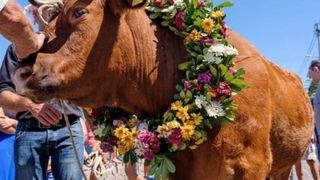In Lesvos, some festivals make headlines not for their music and dance, but for something much darker hidden behind the word “tradition.” We are talking about the public slaughter of bulls and horse races. This centuries-old custom now sparks an increasingly intense debate about animal abuse, public safety, and society’s stance.
It is no coincidence that every year more and more reactions and protests emerge. Animal welfare organizations, politicians, and concerned citizens condemn this custom and urgently demand its end. But what is this tradition really about, what implications does it have for safety, public health, and animal welfare, and what does it reveal about our society?
In Agia Paraskevi, Lesvos, at the festival of Saint Charalambos, one can witness a sacrifice: the parading and killing of a bull, with the tolerance of the State and the blessing of the Church. Tradition links it to a 19th-century legend in which the saint “saved” a farmer and his animal from a Turkish raider. Today, this has evolved into a four-day event—including horse races—that normalizes violence in all its forms.
There are three points we must focus on as thinking individuals.
Abuse
The most obvious and immediate dimension is the abuse and exploitation of animals. At this and other village festivals in Lesvos, bulls are transported, paraded, decorated, and then slaughtered for the amusement of the crowd. The practice is tied to the dish kiskeki, distributed to the public, with the animal sacrificed as an “offering.” It is essentially a public spectacle built on the death of an animal.
In the so-called “horse races,” animals are subjected to exhausting conditions, often without proper safety measures, forced under harsh use of bits and spurs, while the crowd cheers and alcohol flows. Accidents are frequent, with injuries to both animals and riders.
Beyond the animal welfare aspect, even common sense shows that this is not “tradition” but the reproduction of violence and death at the expense of defenseless creatures.
Safety
Less discussed, but equally serious, is the dimension of public safety. The parading and eventual slaughter of a large animal (even if it takes place in a controlled environment) in the presence of crowds, often with children, is inherently dangerous. A stressed animal can react violently. In the past, incidents of panic and injuries have been reported. The same applies to the horse races, where accidents occur in front of the public due to the absence of safety precautions.
Additionally, exposing children and young people to animals being paraded and decorated, knowing their ultimate fate, as well as to races, normalizes violence and fosters indifference toward abuse. These images—even without blood in the foreground—can be traumatic experiences, regardless of whether they are framed as “customs.”
There is also a public health dimension regarding the slaughter. In recent years, under strong pressure, it now takes place in a slaughterhouse. Still, the mass distribution of meat requires strict controls and official veterinary oversight. Hygiene rules must be followed rigorously; otherwise, the risk of contamination rises, with serious consequences for public health. In short, this is not only an animal welfare issue but also a safety issue.
Acceptance
There is, however, a third and perhaps more troubling dimension: our perception. Why is there such social acceptance? Why do people participate? A main reason is that locals and visitors alike see these festivals as part of their cultural identity. Participation is not, in their view, an “endorsement of violence.” Festivals are also places of gathering and celebration. People take part in sharing a collective identity, not necessarily in the killing.
But what happens when the defining elements of a festival are precisely those we described above? When tradition collides with ethics, common sense, and animal rights?
This is where the real question arises: Can we, today, call “tradition” a ritual based on the torment and killing of animals? Can a celebration be synonymous with pain? The preservation of such practices in our times is not culture. It is an obsession with a past we should have outgrown. And if we truly want festivals to be an expression of community and joy, then they cannot be built on blood.
Yes, social division may sometimes be observed, but there is a line where traditions must yield. That line is where abuse begins and respect for life ends.
